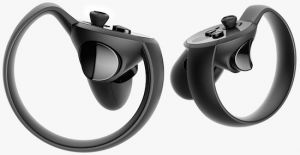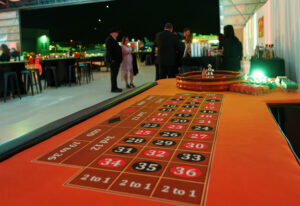What Your Attendees Need To Experience Virtual Reality
Remote Attendees
Although it’s possible to get a limited view of VR content via the screen of a mobile device (we’ll come to that later), the first thing every attendee will need is a VR headset. At the moment, these differ hugely in price and quality. At the top of the range are devices like the HTC Vive (pictured below) and Facebook-owned Oculus Rift; at the bottom, you’ve got Google Cardboard. Where Cardboard differs is its DIY approach. The device itself is just a cardboard frame and a pair of lenses into which you slide your smartphone. There are also other headsets which use a mobile device as the viewing screen such as the Samsung Gear VR. At the moment, the user experience and overall quality generally increase with price.
Read more at http://www.eventmanagerblog.com/attendees-experience-events-virtual-reality#c3CLBpRcDkXSPkBA.99
At the Venue
If you’re providing headsets at the venue, it makes sense to go with one of the more expensive, fully featured headsets. If you rely on your audience to provide the running gear (smartphone), you’ll need a LOT of headset options.
A Computer
Remote Attendees
We’re using the term “computer” very broadly here. As discussed above, in some cases the computer can be a mobile device. For the more expensive, fully featured headsets, you’re going to need a fairly powerful computer to power them.
As mobile devices get better and VR becomes more common, it won’t be long before a mobile handset will have enough power to run high-end VR. Also, small computing platforms like Raspberry Pi are also getting better and cheaper. We think most of the processing concerns will be a thing of the past by 2020.
We can’t talk about devices without giving a mention to 360º video. Like VR, it gives you a more immersive experience but unlike VR it’s only two-dimensional (for now). One of the advantages of 360º video is that it can be experienced through the screen of a mobile device or computer with no extra hardware. This makes the format ideal for broadcasting over social media or via event websites and apps.
At the Venue
For remote attendees, computing power is unlikely to be much of a problem but at the venue, it comes with some issues. Although you don’t technically need one computer per headset, each one will require a fair bit of graphics processing. If you’re supplying them yourself, the cost could run to around $2,000 per attendee. Of course, this cost will come down and there are cheaper options but cheaper means slower. Slower isn’t good because it only takes a few milliseconds of lag and the experience can be truly nauseating.
Headphones
Remote Attendees
Video is only part of the VR experience. Your attendees will also need headphones to explore the virtual soundscape. Most headset manufacturers sell these as optional extras and some even clip to the headset. Most will also allow standard headphones to be plugged in.
At the Venue
Bear in mind that if you’re expecting attendees to provide their own headphones, adapters may be needed. So far we’ve not seen any that use Apple’s Lightning connector.
Controllers
Remote Attendees
If you want your attendees to be able to engage with VR content, they will need the tools to do so. Hand controllers are the most common (Oculus Touch pictured below) at the moment but gesture sensors (like Microsoft Kinect) and voice control are becoming more popular.
image: http://www.eventmanagerblog.com/wp-content/uploads/2017/02/Oculus-Touch-1-300×155.jpg
At the Venue
Voice control might not be ideal in noisy environments, or environments where you only want to hear the content, not the audience around you. Voice mufflers like the Hushme and noise cancelling headphones might go some way to solving this issue.
VR Adoption In Events
Now that you’ve got an idea of what your attendees will need, let’s take a look at where VR has been used so far in events.
Conferences & Keynotes
Intel recently proved that it was possible to equip a whole auditorium with headsets and host a press conference in VR. At this year’s CES, they kitted the auditorium out with over 200 headsets for attendees.
Sports
Super Bowl LI was probably the biggest sports VR event of the year so far. Sports fans were able to watch several highlights from the game and experience other parts of the event in both full VR and 360º video. Parts of the Rio Olympics last year were also broadcast in VR.
Award Ceremonies
360º video is the current (almost) VR star where award ceremonies are concerned. For some time now, experiencing a 360º view of the red carpet and all the glamour that goes with it seems to have become a standard. The flexibility and portability of the camera equipment (in some cases, just a pair of glasses) can also give viewers a glimpse behind the scenes.
Fashion Shows
New York Fashion Week gave the fashion world a glimpse of what VR can do. FTL Moda and Samsung used VR to create an immersive experience for displaying the work of fashion designers. Essentially a virtual fashion show inside a real fashion show.
Concerts
Virtual reality can give remote attendees an experience similar to being in the venue. One of the earliest examples of this was Paul McCartney’s foray into the virtual world, back in 2014. Since then, several concerts have caught on. By the end of this year, it’s likely that VR at concerts will be the rule rather than the exception.
Weddings
Yes, you read that correctly. Virtual reality weddings are a thing. Or at least they will be. In May, the world’s first full VR wedding will be happening inside a florist’s in Wales.
In Conclusion
Virtual reality is still very much an emerging technology but despite the barriers to entry, it is taking the event industry by storm. So far this year we’ve seen several creative uses for VR and its less tech-heavy sibling, 360º video and there are no signs of the trend slowing. As the technology becomes more available the cost will come down and supporting devices will be better optimised for VR. If you’re already using VR at your events, we’d love to hear about it. If you’re not, you probably will be soon.
Read more at http://www.eventmanagerblog.com/attendees-experience-events-virtual-reality#c3CLBpRcDkXSPkBA.99





















